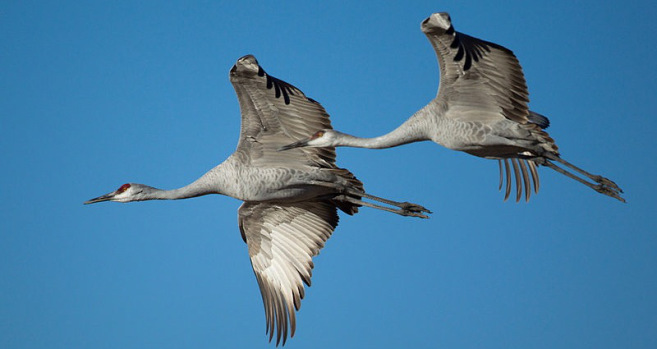 *More on Colorado birdwatching from a Copper Mountain basecamp in this blog post.
*More on Colorado birdwatching from a Copper Mountain basecamp in this blog post.
One of Colorado's greatest wildlife migrations is nearing its peak, as vast flocks of sandhill cranes stop in the San Luis Valley on their way from New Mexico north to Montana, Idaho and Canada. By mid-march, the fields, ranches and wetlands in the valley may see as many as 25,000 cranes.
"People in Colorado should take time to see the cranes; the migration is truly one of nature's wonders," said Rick Basagoitia, area wildlife manager for Colorado Parks and Wildlife in the San Luis Valley.
The annual San Luis Valley Crane Festival is scheduled for this weekend, March 13-15. The cranes start arriving in late-February, stopping in the valley to rest-up and re-fuel for the rest of the trip. Cranes are among the oldest living species on the planet with fossil records going back 9 million years. The birds that migrate through Colorado are the largest of the North American sandhill subspecies standing 4-feet tall with a wing-span of up to 7 feet and weighing in at 11 pounds. Besides their imposing size, the birds issue a continuous, distinctive and haunting call.
At this time of year cranes are engaged in their mating ritual and the birds perform an elaborate and elegant hopping dance to gain the attention of other birds.
The birds are most abundant at the Monte Vista National Wildlife Refuge, located 6 miles south of the town of Monte Vista on Colorado Highway 15. The birds also are easily seen in farm and ranch fields around Monte Vista.
Wildlife watchers can also see the birds at the Alamosa National Wildlife Refuge located southeast of the town of Alamosa, and at the Rio Grande, Higel and Russell Lakes state wildlife areas. Plenty of birds can also be seen in the many agricultural fields near Monte Vista and Alamosa.
The cranes are most active at dawn and at dusk when they're moving back and forth from their nighttime roosting areas. Be sure to dress warm as temperatures can be very cold in the valley.
During the three days of the festival, free tours are offered at 7 a.m. and 4 p.m. when the birds are most active. Visitors take buses to various spots on the wildlife refuge, and local experts talk about the migration and the refuge. If you want to take a tour, be on time because the buses leave promptly.
The festival headquarters and starting point for the tours is the Ski Hi Park building located near U.S. Highway 160 on Sherman Avenue on the east side of Monte Vista. Visitors can pick up maps, schedules and information at the headquarters.
Besides the tours, a variety of workshops are put on by bird, wildlife and photography experts. An arts and crafts fair continues through the weekend at the headquarters building. The crane festival is organized by the local crane festival committee, with help from the Colorado Parks and Wildlife, the U.S. Fish and Wildlife Service, Rio Grande County, SLV Ski Hi Stampede, Monte Vista school district, and the city of Monte Vista.
The number of cranes in the valley peaks in mid-March and many linger through the month. So even if you can't go the weekend of the festival there's still plenty of time to see the birds.
Birdwatchers who travel on their own should be cautious when parking, getting out of vehicles and walking along roads. People are also asked to view birds from a distance with binoculars and spotting scopes, and to observe trail signs and closure notices.
Many other bird species - including eagles, turkeys and a variety of waterfowl – can also be seen throughout the San Luis Valley.
Approximate distances to Monte Vista: Denver, 220 miles; Colorado Springs, 182 miles; Salida, 85 miles; Vail, 175 miles; Durango, 135 miles; Grand Junction, 230 miles.
For more information on the Monte Vista Crane Festival, see: www.cranefest.com.
To learn more about sandhill cranes at this Colorado Parks and Wildlife web page.
Filed in Colorado News |